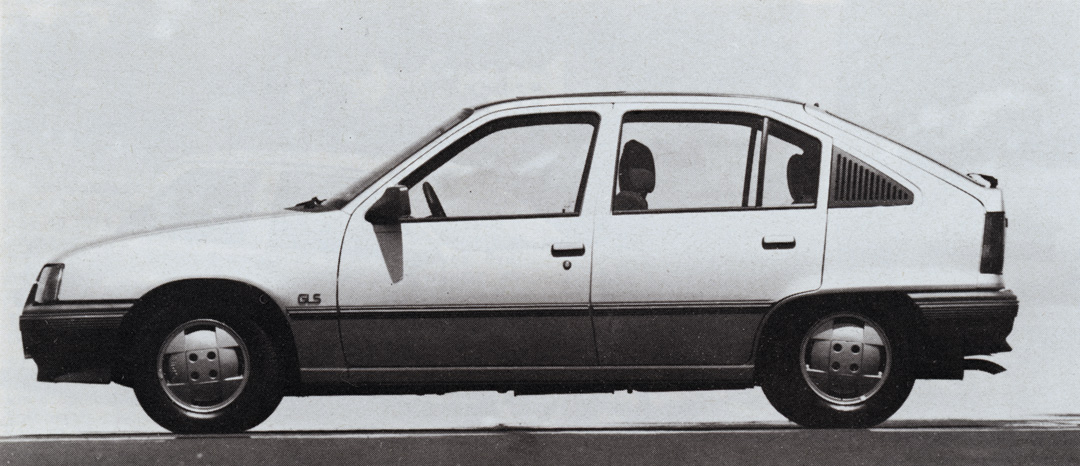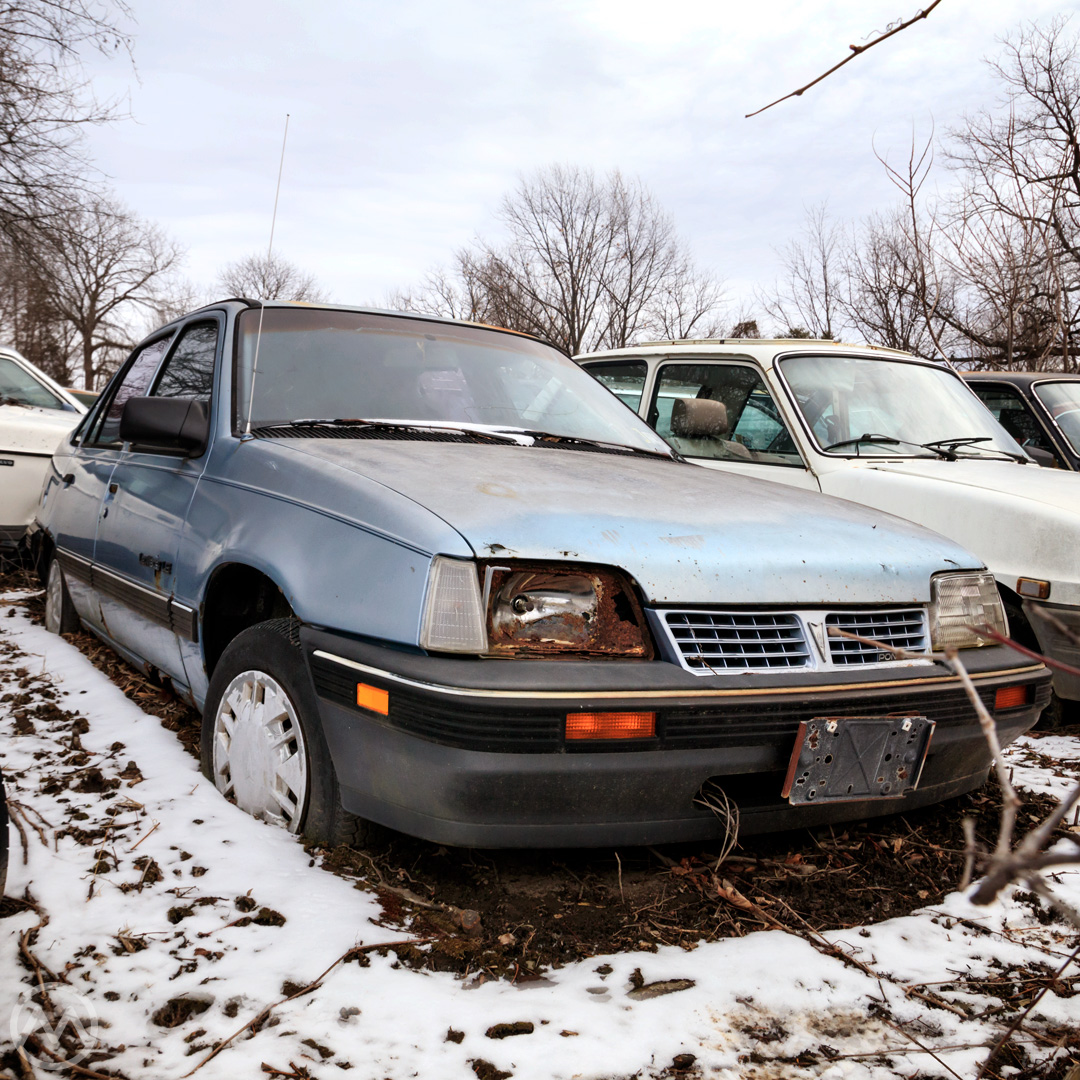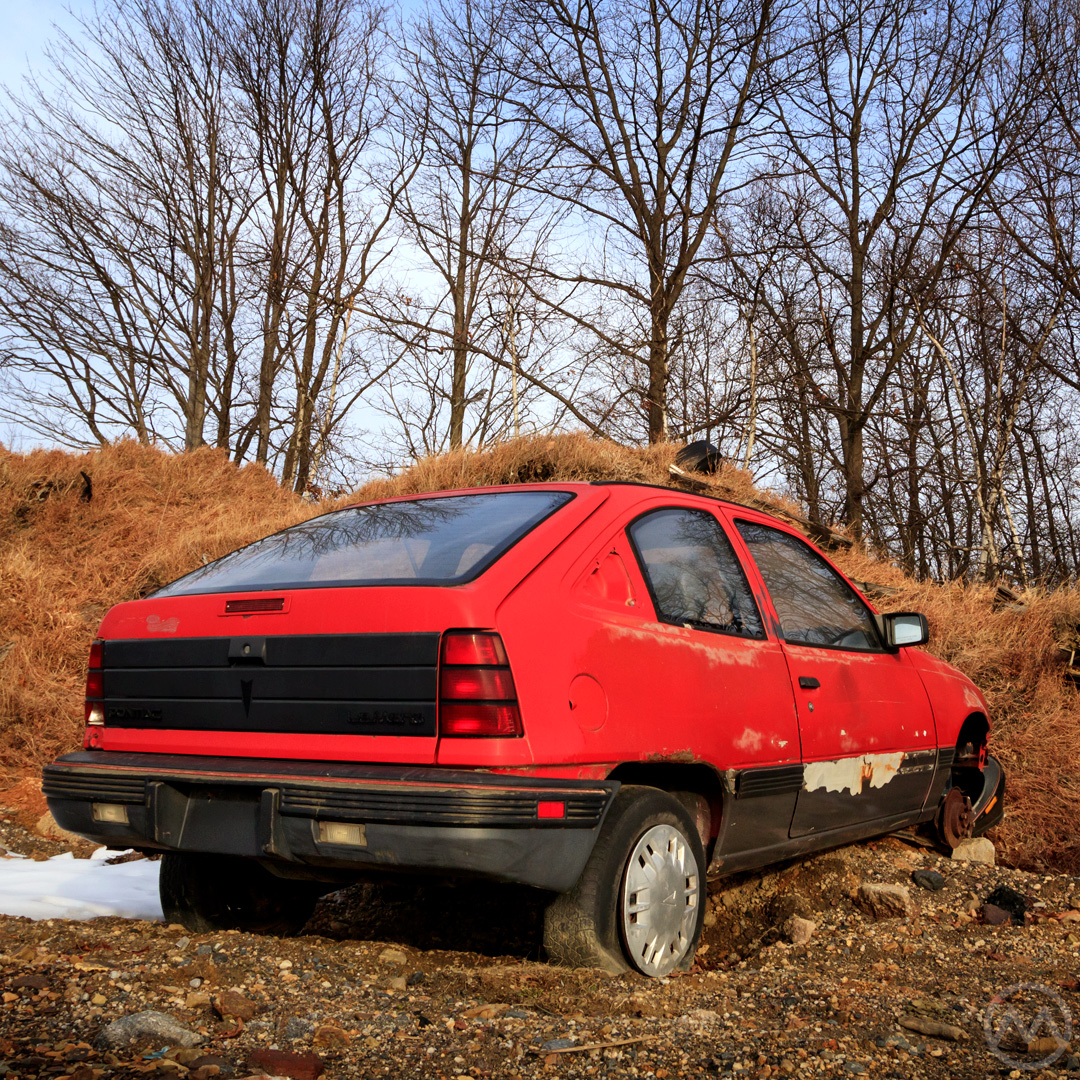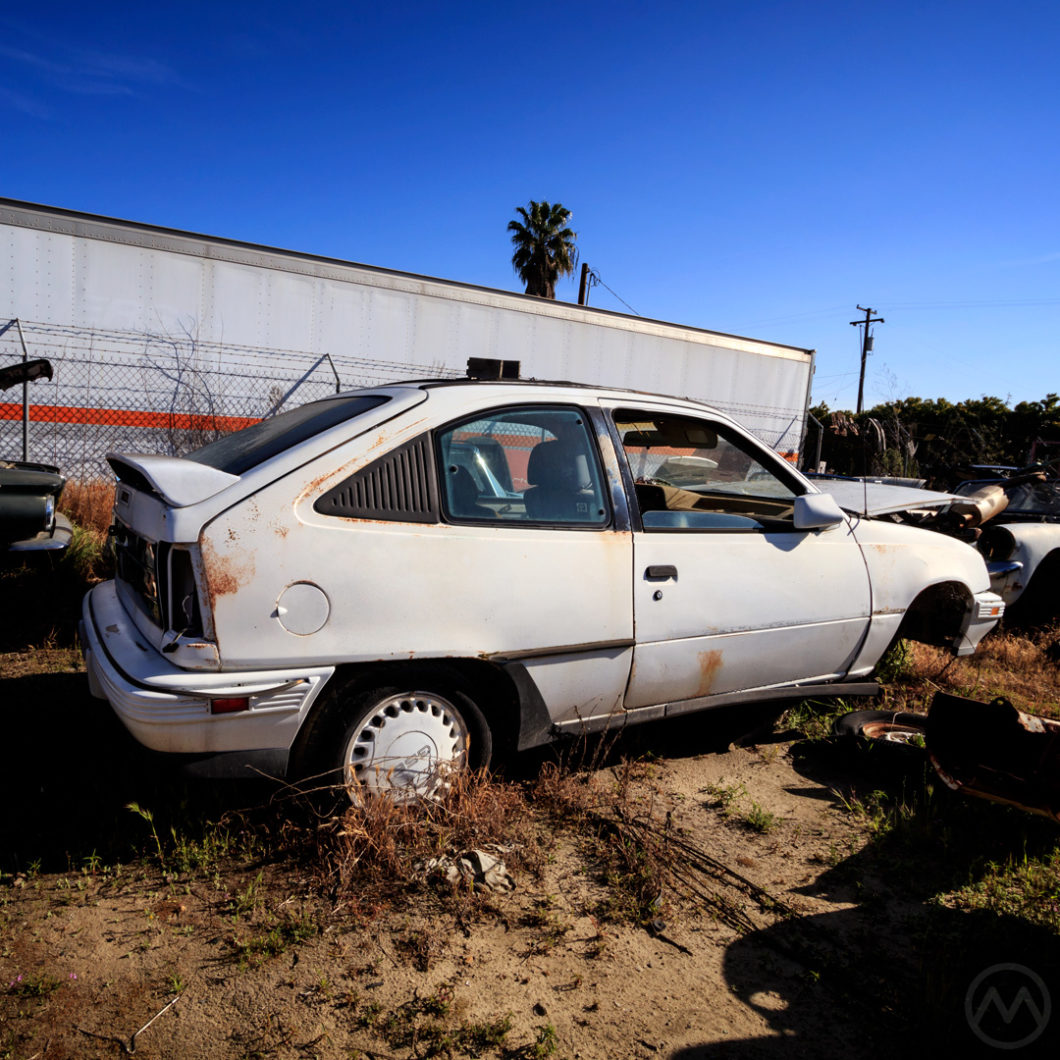It seemed like a great idea – take a respected small car designed in Germany, where engineers know about good dynamics and quality cars, manufacture it cheaply in South Korea, then sell it in America under a familiar name.
The car was the 1987-1993 Pontiac LeMans, which revived a famous Pontiac label that had been dormant since 1981. This LeMans would be quite unlike all the previous ones, however. The late eighties LeMans was a lightweight, front-drive, teardrop-shaped small car with a genuine Euro-style Hot Hatch at the top of the line – the GSE.
It was Euro-style because in effect, it was a European car. The base vehicle was the Opel Kadett E, European Car of the Year in 1984 and a massive seller on the continent. The Kadett was a good car, but expensive to build according to Detroit’s bean counters, and therefore difficult to sell in the USA.
That was, of course, until GM figured out it could build the car in South Korea with its existing small-volume partner Daewoo. As the Kadett E was ramping up to production, GM was planning to announce a new joint venture with Daewoo that would greatly expand its capabilities and make way for a Korean version of the Kadett to come stateside. By the time the plant was finished, however, South Korea was in chaos and GM and Daewoo never saw eye to eye on how to manage it. That discord directly affected the output of the cars and their quality.
Since the LeMans was a reworked version of the Opel Kadett, our story starts half a world away and several years earlier in Russelsheim, Germany.
Kadett E
The Kadett name dated back to the 1930s, and the evolution of the modern, small Kadett to 1962. Americans had been offered the first two generations of Kadett (“A” and “B”) and, in a manner of speaking, the third (“C”). The rear-drive T-body Kadett C shared a great deal with both the Chevrolet Chevette and the obscure Buick Opel Isuzu. That latter car was the Japanese version of the Kadett C, built by Isuzu but marketed (briefly) by Buick.
But in the summer of 1979, the Kadett was completely reinvented into a much more modern car. The Kadett D featured a transverse engine and front wheel drive in the mode of the VW Golf Mk1. A sophisticated car, the Kadett D (and derivative mk1 Vauxhall Astra) was an instantly good seller and a good car to drive, but it did not come stateside.
At the time, GM was launching the North American front-drive X-cars, in which it had invested huge sums. The Kadett D was deemed too expensive to produce in North America at a small car price point, and instead GM chose to retain the old rear-drive Chevette for the USA and Canada (where it was marketed as a Chevy and Pontiac).
The Kadett D was a big seller, but Opel did not rest on its laurels at the time. It was followed up in 1982 with an equally modern supermini, the Mk1 Corsa, designed under Opel veteran Erhard Schnell, the penman behind the original Opel GT.
Opel’s design department in the early 1980s was packed with present and future stars. Veterans Schnell, Murat Nasr, George Gallion, Hans Seer, and Hideo Kodoma were a deep bench. Working under them were a gaggle of future stars – Chris Bangle and Joji Nagashima would go on to fame at BMW; Gert Hildebrand, who joined in 1980, later helmed Mini’s studios.
Kodama, who spent 38 years working at Opel, later described the studio as international, cosmopolitan, and collaborative. It was run by execs from Detroit, generally – and in 1980 the baton passed from Hank Haga (most associated with the 1970+½ Camaro) to Gordon Brown.
Brown, who’d worked his way up through the Pontiac, Oldsmobile, and Chevrolet studios, had his eyes on an aerodynamic future.

The first signs of what was to come for the Kadett, which had been remade into a small, light, front-driver in 1979, were the 1981 Tech-1 and 1983 “Junior” concepts. Neither was a prototype for the Kadett, but both reflected the wind-cheating “aero” looks that would dominate the 1980s. In the meantime, the Kadett E was undergoing thousands of hours of wind-tunnel testing.
The basic underpinnings of the car were refinements of the Kadett D, but with major revisions and an entirely new, very rigid shell. The teardrop shape seems to have been designed under Brown and Seer, who would later become Opel’s first European design director. Primarily, it was designed as a 3- or 5-door hatch, but the range of models would be extremely comprehensive – 3- and 5-door wagons, a 3-door van, a 4-door sedan, and eventually a convertible.
The drag coefficient was just .32 for the basic models, .30 for the high-performance GSi.
The striking shape and modern mechanical pieces gave the car excellent handling and performance and when it first appeared in the summer of 1984. The styling looked very futuristic, even shocking, compared to the Kadett D.
A long range of engines was offered alongside the wide number of body styles too – from a humble 55-horse 1.2 up to the 1.8L, 115-hp GSi. The cars were light too – just 2,200 lbs. for a loaded GSi.
The “E” was hugely successful, winning the 1984 European car of the year award and finding wide popularity. Opel production rose 10% in 1985 on the strength of the first full year of Kadett E sales.
The Korean Connection
The “E” was a bona fide hit, but as in 1979, GM believed it a non-starter for North America due to its cost. It would be too expensive to build in North America, and phohibitively pricey to import from Germany. However, company execs were already looking to find a way to build the cars cost-effectively enough to make them price competitive in the U.S.
Even before the Kadett E reached European forecourts, GM was announcing a deal to build a joint factory with Daewoo in South Korea. Daewoo chairman Kim Woo-jung and Roger Smith were all smiles signing the deal in front of the Korean press. That was in January, 1984, and was part of a sweeping plan to supplement GM’s North American cars with captive imports.
The plan was already underway with New United Motor (NUMMI), a joint venture with Toyota, and with GM’s partners Isuzu and Suzuki, but South Korea was different. In 1984, South Korea’s car industry was much younger than Japan’s and although Hyundai had recently ventured into Canada, no Korean car had ever been exported to the United States.
The country had also been rocked by major political earthquakes every few years from 1948 to 1980, with the unrest of that year resulting in the (sometimes violent) military dictatorship of Chun Doo-hwan.
The Chun era was more stable than the late 1970s, but a dictatorship can do what it wants. In 1981, the Chun regime temporarily forced Kia Motors to give up car production, it also kept wages low. Kia was only able to resume cars after Ford and Mazda promised investment, which led to the Ford Festiva.

GM had partnered with Saehan Motors since 1972, which was then bought out by the much larger Daewoo group in 1982. In 1984, Daewoo was building two Opel derivatives, the old rear-drive T-car (Chevette/Kadett C) as the Maepsy, and the Daewoo Royale, a reworked version of the Rekord D. That year it produced about 27,000 cars – a record for them, but for export GM would need much, much more.
In June, both GM and Daewoo agreed to invest $100M USD each in a new factory to build a version of the Kadett D. The day-to-day of the operation would be run by Daewoo, and because wages were low in South Korea, the unit cost of the car would be significantly (40% or more) below what it cost to build in Germany. The technical expertise and the tooling would come from GM, with American and German input.
GM planned initially to import 80-100,000 cars a year from South Korea beginning as soon as late 1986. The plan seemed solid until the Chun regime began to fall apart in 1986.
Chun’s pronouncements about returning control of the state to democratically elected leaders rang increasingly hollow after the 1985 national assembly elections – in which reform candidates swept to victory but could do little to change anything. Student activists protested the regime, and when one of them, Bak Jong-cheol, died in January, 1987, during an interrogation into protest activities, support for Chun nosedived.
Already having struck for better wages and civil liberties, South Korea’s unions struck again as part of the protest – and the new operation at GM-Daewoo ground to a halt. The entire first half of 1987 would see increasing political unrest in South Korea culminating in the June Democracy struggle, which led to the appointment of President Roh Tae-woo.
Roh was an ally of Chun and a hand-picked successor. His appointment triggered another wave of massive nationwide protests. More than 3,400 separate strikes happened in South Korea in 1987, virtually all of them about civil liberties, elections, and wages. Roh got the message and fair elections (which he narrowly won) took place that December.
Daewoo doubled workers wages to put the troubles behind them. That, of course, meant that production was now more expensive than GM had planned – but still cheaper than the Opel builds.
The Pontiac LeMans
During the troubled period of the plant construction and setup, GM reworked the Kadett for cheaper manufacture in South Korea. The design was basically the same, but some of the components destined to be used in the U.S.-models would be different.
The car would come over as a Pontiac – the division that was probably closest to “Euro-style” at the time. It would finally replace Pontiac’s version of the Chevette, the aging T1000, and offer something like class parity with cars like the Honda Civic.
Pontiac was then led by J. Michael Losh, who’d come to the job in mid-1984. To Losh, the Kadett GSi looked like a perfect fit for the “excitement” division in a way that imports from Suzuki and Isuzu did not, and he expected a considerable gain in sales from offering a “hot hatch” so popular in Europe.
The car had to be affordable, however, and be easy to certify for US sale. The car would come with two engines – a Daewoo-built 74-hp 1.6L version of GM’s “family 1” engine, similar to the 1.6 in the Kadett, and a Holden-built, 96hp 2.0L “family 2” engine, not dissimilar to the American-built LT2 used in the Pontiac J2000/Sunbird. The 2.0 would get a close ratio five-speeder built by Isuzu, while the 1.6L cars had wider ratio manuals or a 3-speed auto.
It would revive a famous Pontiac name – LeMans – and the 2.0L version would be the “GSE,” with lines and graphics not dissimilar to Opel’s GSi. Very little would be altered about the styling, but the light, flush Euro bumpers were banished in favor of bigger, plastic-covered North American units and a Pontiac Grill.

Unlike the vast array of bodies available in Europe, the LeMans would come as only a 3-door hatch (Aerocoupe Value Leader, LE, or GSE) or a 4-door sedan (SE).
Cars began trickling into the USA in 1987, but didn’t really start rolling until the fall of that year. The faster, fancier GSE came last, not really arriving in numbers until early 1988. The Kadett was a family car in Europe, but Americans saw the LeMans as a pure economy car – and given that some of the materials (plastics, cloths) had been skimped on to keep costs down, they felt cheap too.
The cars drove quite well – as you’d expect from the dynamics of the Opel – and initially, customers liked them. They sold much better than the old T1000 – in the first 18 months, almost 100,000 were sold (as 1988 models) That was a little below GM’s expectations but considering how hard it had been just to get the cars on the boat, everyone was happy. For a little while.
In Korea, the partners fought constantly even when the assembly line was humming. Daewoo managers felt that GM execs were patronizing and disrespectful. GM felt Daewoo managers weren’t enforcing quality standards.
Daewoo’ Kim Woo-jung wanted to export even more cars and set up a deal to export them to then-communist Eastern Europe. GM nixed the deal on the basis that Europe was Opel’s territory and Daewoo would not be allowed to sell its version of the Kadett against Opel’s. GM forbade Daewoo from selling in Europe thereafter. Daewoo developed a redesigned GM J-car with the help of Bertone and offered it to GM as another American export. GM refused it.
During this back and forth, American consumers discovered that the LeMans had a tendency to fall apart – or at least have many little quality ills that, in a cheap car, eventually led to an early demise. Sales fell by almost a third in 1989, and fell further still in 1990. Pontiac dealers gradually came to dislike the sight of the LeMans, which often returned to their service drives with unhappy customers.
Chairman Kim, already complaining in public about GM, blamed the poor sales on GM not wanting to market the car. Losh, for his part, believed in the LeMans project and was a strong advocate for it – but he was moved over to Oldsmobile in 1989 to help turn around that division’s flagging fortunes.
The LeMans’ poor reputation was in part offset by its good looks and dynamics – it genuinely was good to drive if a little rougher and louder than the Euro Kadett, but Pontiac had a harder and harder time getting buyers interested. In 1990, sales fell below 40,000 cars.
Although Pontiac was an excitement brand and the LeMans GSE an exciting car, it was never a good seller. Americans viewed the LeMans almost exclusively as cheap wheels – and the $11,000 GSE was a big step up the ladder from the $8,900 sedan or the even cheaper 1.6L hatches. As such, the best and fastest version was dropped in early 1991.
In early 1991, chairman Kim asked GM to expand the partnership and double Daewoo’s output. GM refused. Detroit countered by offering to either buy out Daewoo’s stake, or sell its half of the joint venture to Daewoo. To GM’s surprise, Daewoo bought out GM in November, 1992.
The LeMans continued for a little while but sales were dismal. 19,000 or so units in 1992 and just under 8,000 in 1993. In Canada, where Pontiac had a very strong presence, the car was also marketed under the Asüna and Passport labels, short-lived Canadian equivalents to Chevrolet’s Geo project in the United States.
By 1993, all of the GM versions of the Kadett E had been replaced. There were quite a few variations, as the Kadett E was also built and sold in South America as a Chevrolet.
Strangely, the Pontiac version, created for North America, was also sold in New Zealand – which had no historical associations with Pontiac but which was an easy, low-investment market for GM and Daewoo. Unlike the USA, New Zealand got a 5-door hatch version. Few were sold.
The LeMans’ Afterlife
With GM out of the picture and all of the other Kadett E variations gone, Daewoo was free to market its own version of the car where it wanted – and one of its first destinations was Europe.
In 1995, Daewoo’s Nexia and Cielo, the same cars with a new name and some light facelifting, were part of the company’s first European lineup. Competing with used versions of the Kadett and its Vauxhall equivalents (Astra, Belmont), the Daewoo’s sold primarily on price and features and were considered very basic transportation.
The cheap production of LeMans variations gave Daewoo the capital and time to create its own range of cars, which began to emerge in the late 1990s with the Lanos, Leganza, and most importantly the Matiz, all designed with the help of Giorgetto Giugiaro’s Italdesign and some were styled after rejected concepts for other manufacturers (the Matiz was originally a proposal for Fiat).

The Asian financial crisis of 1997 weakened the larger Daewoo group, which eventually led it to sell off it’s automotive division to … General Motors, in 1999.
The LeMans continued to live through that crisis and others. Produced by a partner company in Uzbekistan, a modified version of the LeMans/Cielo/Nexia remained in production as late as 2016.
By then, seeing a North American LeMans on the road was a black swan event. The cars quickly became bottom-feeder used cars in the 1990s and, as usual, few people save or heavily invest in economy cars. About 240,000 LeMans were sold in the USA from mid-1987 until the end in 1993, but virtually none are still on the road.
Special thanks to Turners Auto Wrecking, Joe O., and Bonner’s Auto Parts for todays photo opportunities. Additionally – If you have a pristine 1987-93 LeMans, we’d love to see it!


As of early 2022…I’ve still got my 1989 Pontiac Le Mans which I purchased new in October, 1988! The red three door hatchback! I actually had it fully restored in 2018! At 254,00 miles the car still runs really well and still looks mint!. I fully expect to retain it indefinitely at this point! It is still a really fun little car to drive!!! And rare as hell these days! I don’t know how many years it has been since I have seen another one on the road!
The reason of asking how IS the quality of the Pontiac Le Mans car is seemly lots of people complaining about the the Chevy Aveo/ Pontiac,Wave/ G-3 cars makes you wonder did they have the same issues with the LeMans too? Because those newer models shared the same parts and production build, so quality couldn’t have been that different.
And as of July, 2024…My 1989 Pontiac Le Mans is still on the road…Still running really well and still looks great!!!